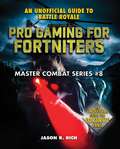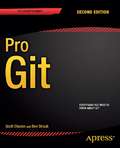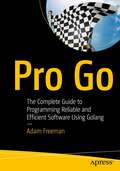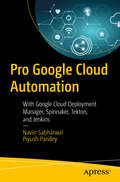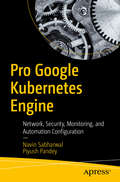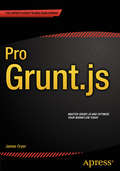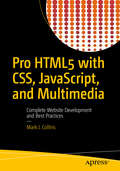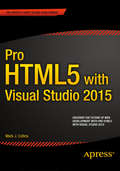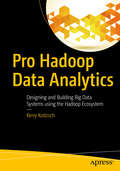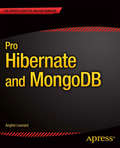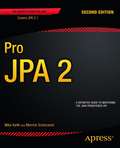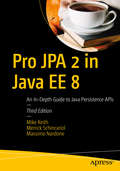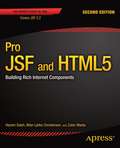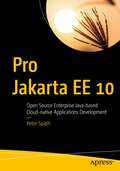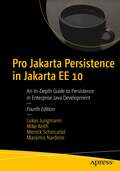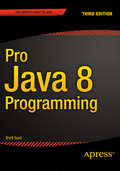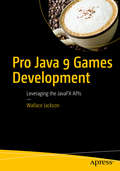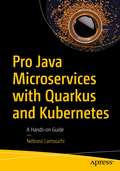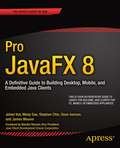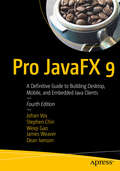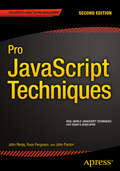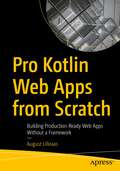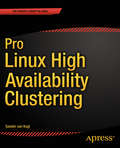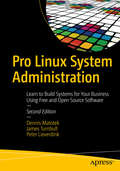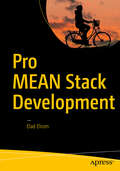- Table View
- List View
Pro Gaming for Fortniters: An Unofficial Guide to Battle Royale (Master Combat #8)
by Jason RichFor Any Gamer who Has Dreamed of Joining a Pro Gaming Team and Bringing Home $100 Million in Prize Money! Find out what it takes to enter, win, and eventually work your way toward the ultimate live gaming competition: the Fortnite World Cup. Pro Gaming for Fortniters will tell you everything you need to know to compete from home (for free!) in some of the most exciting and lucrative showdowns on Earth. Using the valuable tips in this illustrated, information-packed guide, you&’ll be better equipped to: train for and enter the world of competitive gamingupgrade your gaming equipment so you have what you need to winstream your game play experiences online for an audienceprogress to more advanced Fortnite contests and become a member of a pro-gaming teamdiscover crucial winning strategies, and showcase your talents for all to see Whether you play Fortnite: Battle Royale on a PC, Mac, Xbox One, PlayStation 4, Nintendo Switch, or your mobile device, inside you&’ll find the essential tips and secrets you need to be taken seriously in the world of pro gaming. With this illustrated, easy-to-use guide, you&’ll gain crucial inside information that can turn your dream into a reality. Pro Gaming for Fortniters provides the ultimate, unofficial player advantage for gaming experts in the making.
Pro Git
by Ben Straub Scott ChaconPro Git (Second Edition) is your fully-updated guide to Git and its usage in the modern world. Git has come a long way since it was first developed by Linus Torvalds for Linux kernel development. It has taken the open source world by storm since its inception in 2005, and this book teaches you how to use it like a pro. Effective and well-implemented version control is a necessity for successful web projects, whether large or small. With this book you'll learn how to master the world of distributed version workflow, use the distributed features of Git to the full, and extend Git to meet your every need. Written by Git pros Scott Chacon and Ben Straub, Pro Git (Second Edition) builds on the hugely successful first edition, and is now fully updated for Git version 2. 0, as well as including an indispensable chapter on GitHub. It's the best book for all your Git needs. What you'll learn * Effectively use Git, either as a programmer or a project leader * Become a fluent Git user * Master branching, using Git on the server, and on other systems * Integrate Git in your development workflow * Migrate programming projects from other SCMs to Git * Extend Git for your personal project needs * Effectively use GitHub Who this book is for This book is for all open source developers: you are bound to encounter Git somewhere in the course of your working life. Proprietary software developers will appreciate Git's enormous scalability, since it is used for the Linux project, which comprises thousands of developers and testers. Table of Contents 1. Getting Started 2. Git Basics 3. Git Branching 4. Git on the Server 5. Distributed Git 6. GitHub 7. Git Tools 8. Customizing Git 9. Git and Other Systems 10. Git Internals
Pro Go: The Complete Guide to Programming Reliable and Efficient Software Using Golang
by Adam FreemanBest-selling author Adam Freeman explains how to get the most from Go, starting from the basics and building up to the most advanced and sophisticated features. You will learn how Go builds on a simple and consistent type system to create a comprehensive and productive development experience that produces fast and robust applications that run across platforms. Go, also known as Golang, is the concise and efficient programming language designed by Google for creating high-performance, cross-platform applications. Go combines strong static types with simple syntax and a comprehensive standard library to increase programmer productivity, while still supporting features such as concurrent/parallel programming. Each topic is covered in a clear, concise, no-nonsense approach that is packed with the details you need to learn to be truly effective. Chapters include common problems and how to avoid them. What You Will Learn Gain a solid understanding of the Go language and tools Gain in-depth knowledge of the Go standard library Use Go for concurrent/parallel tasks Use Go for client- and server-side development Who This Book Is For Experienced developers who want to use Go to create applications
Pro Google Cloud Automation: With Google Cloud Deployment Manager, Spinnaker, Tekton, and Jenkins
by Navin Sabharwal Piyush PandeyDiscover the methodologies and best practices for getting started with Google cloud automation services including Google Cloud Deployment Manager, Spinnaker, Tekton, and Jenkins to automate deployment of cloud infrastructure and applications. The book begins with an introduction to Google cloud services and takes you through the various platforms available to do automation on the GCP platform. You will do hands-on exercises and see best practices for using Google Cloud Deployment Manager, Spinnaker, Tekton, and Jenkins. You’ll cover the automation aspects of the Google Cloud Platform holistically using native and upcoming open source technologies. The authors cover the entire spectrum of automation from cloud infrastructure to application deployment and tie everything together in a release pipeline using Jenkins. Pro Google Cloud Automation provides in-depth guidance on automation and deployment of microservices-based applications running on the Kubernetes platform. It provides sample code and best practice guidance for developers and architects for their automation projects on the Google Cloud Platform. This book is a good starting point for developers, architects, and administrators who want to learn about Google cloud automation. What You Will Learn Gain the fundamentals of Google’s automation-enabling servicesSee an architecture overview for Google Cloud Deployment Manager, Spinnaker, Tekton, and JenkinsImplement automation for infrastructure and application use casesAutomate microservices-based applications running on GKEEnable Google Cloud Deployment Manager, Spinnaker, Tekton, and Jenkins Who This Book Is For Developers, architects, and administrators who want to learn about Google cloud automation.
Pro Google Kubernetes Engine: Network, Security, Monitoring, and Automation Configuration
by Navin Sabharwal Piyush PandeyDiscover methodologies and best practices for getting started with Google Kubernetes Engine (GKE). This book helps you understand how GKE provides a fully managed environment to deploy and operate containerized applications on Google Cloud infrastructure.You will see how Kubernetes makes it easier for users to manage clusters and the container ecosystem. And you will get detailed guidance on deploying and managing applications, handling administration of container clusters, managing policies, and monitoring cluster resources. You will learn how to operate the GKE environment through the GUI-based Google Cloud console and the "gcloud" command line interface. The book starts with an introduction to GKE and associated services. The authors provide hands-on examples to set up Container Registry and GKE Cluster, and you will follow through an application deployment on GKE. Later chapters focus on securing your GCP GKE environment, GKE monitoring and dashboarding, and CI/CD automation. All of the code presented in the book is provided in the form of scripts, which allow you to try out the examples and extend them in interesting ways.What You Will LearnUnderstand the main container services in GCP (Google Container Registry, Google Kubernetes Engine, Kubernetes Engine, Management Services)Perform hands-on steps to deploy, secure, scale, monitor, and automate your containerized environmentDeploy a sample microservices application on GKEDeploy monitoring for your GKE environmentUse DevOps automation in the CI/CD pipeline and integrate it with GKEWho This Book Is ForArchitects, developers, and DevOps engineers who want to learn Google Kubernetes Engine
Pro Grunt.js
by James CryerPro Grunt. js gets you quickly up-to-speed with this popular JavaScript-based task runner. Author James Cryer takes you from initial installation all the way through to authoring successful plugins. Using hands-on examples you will learn about CSS linting, combination, compilation and minification; JavaScript linting, AMD modules, and templates; image processing and optimizing; and creating a local server. You will then move on to more advanced topics such as LiveReload, Test Automation, Modular configuration, and combining tasks. Finally you will see how to scaffold plugins using Grunt init and Yeoman, how to test them with Mocha and Chai, and how to publish them so others can use them. Start using Grunt. js to improve your workflows by using Pro Grunt. js today. What you'll learn How and when to use Grunt. js. How to work with Grunt. js to optimize your CSS, JavaScript, and images. How to perform more advanced operations with Grunt. js. How to build, test, and publish your very own Grunt. js plugins. Who this book is for This book is for the reader who is familiar with the concepts of JavaScript frameworks and wants to implement Grunt. js into their workflow. Table of Contents 1. Introducing Grunt 2. How to Use Grunt in Your Project 3. Using Grunt with HTML and CSS 4. Using Grunt with JavaScript 5. Using Grunt with Images, SVG, and Icons 6. Using Grunt for Testing and Local Development 7. Optimizing Your Grunt Workflow
Pro HTML5 with CSS, JavaScript, and Multimedia
by Mark J. CollinsGet ahead in HTML5, including markup, styling, and scripting, with many practical examples and best practice insights. You’ll quickly understand HTML5 markup elements and when to use them, and then apply the latest CSS3 features to create amazing web pages.Pro HTML5 with CSS, JavaScript, and Multimedia teaches the fundamentals of client-side scripting and covers the immense functionality available with HTML5. Learn to use JavaScript to create web applications that are dynamic and interactive, and add advanced features, including audio, video, SVG, and drag and drop capabilities. Using practical hands-on demonstrations you will access a larger set of technologies to create more diverse and powerful websites and applications.What You'll LearnHow, and when, to use all the HTML5 markup tagsUse CSS3 features to simplify website designMaster JavaScript fundamentals and advanced featuresLeverage the native browser support for Geolocation, IndexedDB, and drag and drop capabilitiesWho This Book Is ForWeb developers and designers who want to increase their HTML5 skills to create modern interactive websites
Pro HTML5 with Visual Studio 2015
by Mark CollinsPro HTML5 with Visual Studio 2015 is written to help ASP.NET developers make the leap to the inevitable and exciting world of HTML5. With this book, you’ll quickly master the new HTML elements, the improved CSS features, and advanced content including audio, video, canvas, SVG, and drag and drop capabilities. You will also learn how your enterprise applications can benefit from some brand-new technology such as web workers and web sockets. Using practical hands-on demonstrations you will learn all of the really cool features that you can start using now, within your existing ASP.NET applications.HTML5 promises to revolutionize the way web sites are developed with an impressive set of built-in client-side features. The use of HTML5 as a preferred development language in Windows 10, along with growing support from the major browser vendors, is likely to make HTML5 the de-facto standard for all future web development. The number of HTML5-capable phones alone is estimated to top 2 billion by 2016. Many professional web developers who are firmly rooted in the Microsoft toolset such as Visual Studio, Active Server Pages, and .NET are trying to understand how HTML5 fits into their world.Written with the Visual Studio 2015 developer in mind, this book:Illustrates how to integrate the new HTML5 features in an ASP .NET MVC6 applicationExplains how to add active content including video and graphicsDemonstrates the new scripting features of HTML5 such as application cache and local storage
Pro Hadoop Data Analytics
by Kerry KoitzschLearn advanced analytical techniques and leverage existing tool kits to make your analytic applications more powerful, precise, and efficient. This book provides the right combination of architecture, design, and implementation information to create analytical systems that go beyond the basics of classification, clustering, and recommendation. Pro Hadoop Data Analytics emphasizes best practices to ensure coherent, efficient development. A complete example system will be developed using standard third-party components that consist of the tool kits, libraries, visualization and reporting code, as well as support glue to provide a working and extensible end-to-end system. The book also highlights the importance of end-to-end, flexible, configurable, high-performance data pipeline systems with analytical components as well as appropriate visualization results. You'll discover the importance of mix-and-match or hybrid systems, using different analytical components in one application. This hybrid approach will be prominent in the examples. What You'll Learn Build big data analytic systems with the Hadoop ecosystem Use libraries, tool kits, and algorithms to make development easier and more effective Apply metrics to measure performance and efficiency of components and systems Connect to standard relational databases, noSQL data sources, and more Follow case studies with example components to create your own systems Who This Book Is For Software engineers, architects, and data scientists with an interest in the design and implementation of big data analytical systems using Hadoop, the Hadoop ecosystem, and other associated technologies.
Pro Hibernate and MongoDB
by Anghel LeonardHibernate and MongoDB are a powerful combination of open source persistence and NoSQL technologies for today's Java-based enterprise and cloud application developers. Hibernate is the leading open source Java-based persistence, object relational management engine, recently repositioned as an object grid management engine. MongoDB is a growing, popular open source NoSQL framework, especially popular among cloud application and big data developers. With these two, enterprise and cloud developers have a "complete out of the box" solution. Pro Hibernate and MongoDB shows you how to use and integrate Hibernate and MongoDB. More specifically, this book guides you through the bootstrap; building transactions; handling queries and query entities; and mappings. Then, this book explores the principles and techniques for taking these application principles to the cloud, using the OpenShift Platform as a Service (PaaS) and more. In this book, you get two case studies: An enterprise application using Hibernate and MongoDB. then, A cloud application (OpenShip) migrated from the enterprise application case study After reading or using this book, you come away with the experience from two case studies that give you possible frameworks or templates that you can apply to your own specific application or cloud application building context.
Pro JPA 2
by Mike Keith Merrick SchincariolPro JPA 2, Second Edition introduces, explains, and demonstrates how to use the new Java Persistence API (JPA) 2. 1 from the perspective of one of the specification creators. A one-of-a-kind resource, it provides both theoretical and extremely practical coverage of JPA usage for both beginning and advanced developers. Authors Mike Keith and Merrick Schincariol take a hands-on approach, based on their wealth of experience and expertise, by giving examples to illustrate each concept of the API and showing how it is used in practice. The examples use a common model from an overriding sample application, giving readers a context from which to start and helping them to understand the examples within an already familiar domain. After completing the book, you will have a full understanding of JPA and be able to successfully code applications using its annotations and APIs. The book also serves as an excellent reference guide during initial and later JPA application experiences. Hands-on examples for all aspects of the JPA specification Expert insight about various aspects of the API and when they are useful Portability hints to provide increased awareness of the potential for non-portable JPA code What you'll learn How to get started with enterprise applications using JPA 2. 1 Simple and advanced object-relational mapping techiques How to use the complete Entity Manager API How to create queries using the query language (JP QL) and the Criteria API Locking, concurrency, and other advanced concepts How to use XML mapping files and descriptors How to package and deploy your Java Persistence applications How to test your Java Persistence applications Who this book is for The book generally targets enterprise and persistence developers who fall in one of three categories: Those who are new to persistence; we will offer an introduction to persistence and to the basic concepts so these readers can have solid base from which to become proficient at JPA. Those who know and/or use existing ORM persistence products such as Hibernate or TopLink/EclipseLink. Those who have already used JPA and want to learn about newer features introduced by JPA 2. 1, or have a good reference book to consult when they develop JPA applications. In general, we assume that the reader is knowledgeable with Java, SQL, and JDBC, and has a little knowledge of Java EE. Table of Contents Introduction Getting Started Enterprise Applications Object Relational Mapping Collection Mapping Entity Manager Using Queries Java Persistence Query Language Criteria Advanced Object Relational Mapping Advanced Queries Advanced Topics XML Mapping Files Packaging and Deployment Testing
Pro JPA 2 in Java EE 8: An In-depth Guide To Java Persistence Apis
by Mike Keith Merrick Schincariol Massimo NardoneLearn to use the Java Persistence API (JPA) and other related APIs as found in the Java EE 8 platform from the perspective of one of the specification creators. A one-of-a-kind resource, this in-depth book provides both theoretical and practical coverage of JPA usage for experienced Java developers. Authors Mike Keith, Merrick Schincariol and Massimo Nardone take a hands-on approach, based on their wealth of experience and expertise, by giving examples to illustrate each concept of the API and showing how it is used in practice. The examples use a common model from an overarching sample application, giving you a context from which to start and helping you to understand the examples within an already familiar domain. After completing Pro JPA 2 in Java EE 8, you will have a full understanding of JPA and be able to successfully code applications using its annotations and APIs. The book also serves as an excellent reference guide. What You Will Learn Use the JPA in the context of enterprise applications Work with object relational mappings (ORMs), collection mappings and more Build complex enterprise Java applications that persist data long after the process terminates Connect to and persist data with a variety of databases, file formats, and more Use queries, including the Java Persistence Query Language (JPQL) Carry out advanced ORM, queries and XML mappings Package, deploy and test your Java persistence-enabled enterprise applications Who This Book Is For Experienced Java programmers and developers with at least some prior experience with J2EE or Java EE platform APIs.
Pro JSF and HTML5
by Hazem Saleh Allan Lykke Christensen Zubin WadiaPro JSF and HTML5 shows you how to leverage the full potential of JavaServer Faces (JSF) and HTML5. This book is for Java developers who aspire to build sophisticated, enterprise-grade web experiences with HTML5-enabled JSF. Written by JSF experts and verified by established community figures, this book will serve as your primary resource, helping you build or integrate well-designed HTML5-enabled JSF components into your rich internet applications. Pro JSF and HTML5 starts by giving you a firm grounding in the design principles of component-based frameworks and the basics of JSF. It then details recent advancements in JSF 2. 2 that make it friendlier, faster, and more productive than ever before. And it covers HTML5-enabled components, integration with JEE7 standards, 3rd party component libraries, security, and performance. The book concludes with a real-world application that puts everything you learned into practice. In this book you'll learn Foundational JSF topics such as the component life cycle, framework architecture, managed beans and CDI, expression language, conversion and validation, JSF events and view parameters. Leveraging new features in JSF 2. 2 such as Faces Flow, Resource Library Contracts, and Ajax file uploading. Developing Advanced HTML5 enabled components in JSF 2. 2. Creating JSF 2. 2 applications that utilize Java EE 7 technologies (CDI, JPA 2. 1 and EJB 3. 2) for bean management, transaction management and persistence. Building advanced real-world JSF applications with considerations for security, performance, and usability. If you're a Java developer interested in the world of component-based frameworks, Pro JSF and HTML5 is for you. What you'll learn Foundational JSF topics such as the component life cycle, framework architecture, managed beans and CDI (Context and Dependency Injection), expression language, exception handling, conversion and validation, JSF events (faces events, phase events and system events), and view parameters. Utilizing new features in JSF 2. 2 such as Faces Flow, Resource Library Contracts, and Ajax file uploading. Developing Advanced HTML5 enabled components in JSF 2. 2. Developing PrimeFaces and RichFaces applications. Developing JSF 2. 2 applications that utilize Java EE 7 technologies (CDI, JPA 2. 1 and EJB 3. 2) in order to facilitate bean management, transaction management and persistence. Unit testing JSF applications. Stateless JSF views. Implementing Security in JSF applications. Tuning the performance of JSF applications. Translating application requirements into a model and then implementing the model using JSF 2. 2 and Java EE 7 technologies. Who this book is for This is a tutorial and reference is for both intermediate and experienced Java enterprise and web application developers. Table of Contents 01. JSF Introduction 02. JSF Under the Hood - Part 1 03. JSF Under the Hood - Part 2 04. JSF Under the Hood - Part 3 05. JSF2. 2: What's New? 06. Going Deep: JSF Custom Components 07. Basic JSF2 HTML5 Components 08. Advanced JSF2 HTML5 Components 09. JSF Component Libraries 10. Creating a Basic JSF2. 2 Application 11. JSF2 Advanced Topics 12. JSF2 Security and Performance 13. Applying it All: The Mega App
Pro Jakarta EE 10: Open Source Enterprise Java-based Cloud-native Applications Development
by Peter SpäthWelcome to your in-depth professional guide to the open source Eclipse Jakarta EE 10 platform. This book will help you build more complex native enterprise Java-based cloud and other applications that can run in corporate and other mission-critical settings. The majority of the key Jakarta EE 10 APIs or features are dissected in this book, including JSF, JSP, JPA, CDI, REST, Microprofiles, WebSockets, and many more. Along the way, various open source Apache, Eclipse, and other projects are integrated and used for more complete workflows and treatment in general. Jakarta EE 10 comes with a significant number of improvements over Java EE 9 technologies and adopts a series of new technologies. This book starts out with a concise development procedure proposal and shows NetBeans as an alternative IDE to Eclipse. It also talks about versioning, software repositories, and continuous integration techniques. The web tier of enterprise application architectures is covered, including state-of-the-art techniques such as web sockets and front end (JavaScript) related frameworks. The book presents a survey of architecture-related advanced topics, including micro profiles. In a supporting technologies chapter, JSON and XML processing methods are revisited and deepened, and the usage of scripting engines is introduced. A resources chapter discusses enterprise resource integration, such as resource adapters and Hibernate as a mapper between the SQL and the Java world. Also covered is the usage of no-SQL databases. A security chapter shows advanced security enhancement techniques for use of Jakarta EE in corporate environments. The last chapter talks about advanced logging and monitoring techniques, serving both developers and operations staff. What You Will Learn Build complex Jakarta EE applications that run in corporate or other enterprise settingsCreate a professional development workflow using Jakarta EEBuild more advanced web development applicationsWork with more advanced supporting technologies to increase application maturity and stability in a corporate environment Do enterprise resource integration, including custom resource adaptersUtilize security enhancements of enterprise-level Jakarta EE applicationsLeverage techniques to monitor and log in a corporate environment, including memory usage and performance troubleshooting Who This Book is ForExperienced Java programmers and web developers, especially those with some prior experience with the Java EE platform
Pro Jakarta Persistence in Jakarta EE 10: An In-Depth Guide to Persistence in Enterprise Java Development
by Mike Keith Merrick Schincariol Massimo Nardone Lukas JungmannLearn to use the Jakarta Persistence API and other related APIs as found in the Jakarta EE 10 platform from the perspective of one of the specification creators. A one-of-a-kind resource, this in-depth book provides both theoretical and practical coverage of Jakarta Persistence usage for experienced Java developers.Authors Lukas Jungmann, Mike Keith, Merrick Schincariol, Massimo Nardone take a hands-on approach, based on their wealth of experience and expertise, by giving examples to illustrate each concept of the API and showing how it is used in practice. The examples use a common model from an overarching sample application, giving you a context from which to start and helping you to understand the examples within an already familiar domain. After completing this in-depth book, you will have a full understanding of persistence and be able to successfully code applications using its annotations and APIs. The book also serves as an excellent reference guide.What You Will LearnUse Jakarta Persistence in the context of enterprise applicationsWork with object relational mappings (ORMs), collection mappings and moreBuild complex enterprise Java applications that persist data long after the process terminatesConnect to and persist data with a variety of databases, file formats, and moreUse queries, including the Jakarta Persistence Query Language (Jakarta Persistence QL)Carry out advanced ORM, queries and XML mappingsPackage, deploy and test your Jakarta persistence-enabled enterprise applicationsWho This Book Is ForExperienced Java programmers and developers with at least some prior experience with Jakarta EE or Java EE platform APIs.
Pro Java 8 Programming
by Brett SpellPro Java 8 Programming covers the core Java development kit. It takes advantage of the finer points of the core standard edition (SE) and development kit version 8. You'll discover the particulars of working with the Java language and APIs to develop applications in many different contexts. You will also delve into more advanced topics like lambda expressions, closures, new i/o (NIO. 2), enums, generics, XML, metadata and the Swing APIs for GUI design and development. By the end of the book, you ll be fully prepared to take advantage of Java's ease of development, and able to create powerful, sophisticated Java applications. "
Pro Java 9 Games Development
by Wallace JacksonUse Java 9 and JavaFX 9 to write 3D games for the latest consumer electronics devices. Written by open source gaming expert Wallace Jackson, this book uses Java 9 and NetBeans 9 to add leading-edge features, such as 3D, textures, animation, digital audio, and digital image compositing to your games. Along the way you'll learn about game design, including game design concepts, genres, engines, and UI design techniques. To completely master Java 3D game creation, you will combine this knowledge with a number of JavaFX 9 topics, such as scene graph hierarchy; 3D scene configuration; 3D model design and primitives; model shader creation; and 3D game animation creation. With these skills you will be able to take your 3D Java games to the next level. The final section of Pro Java 9 Games Development puts the final polish on your abilities. You'll see how to add AI logic for random content selection methods; harness a professional scoring engine; and player-proof your event handling. After reading Pro Java 9 Games Development, you will come away with enough 3D expertise to design, develop, and build your own professional Java 9 games, using JavaFX 9 and the latest new media assets. What You'll Learn Design and build professional 3D Java 9 games, using NetBeans 9, Java 9, and JavaFX 9 Integrate new media assets, such as digital imagery and digital audio Integrate the new JavaFX 9 multimedia engine API Create an interactive 3D board game, modeled, textured, and animated using JavaFX Optimize game assets for distribution, and learn how to use the Java 9 module system Who This Book Is For Experienced Java developers who may have some prior game development experience. This book can be for experienced game developers new to Java programming.
Pro Java Microservices with Quarkus and Kubernetes: A Hands-on Guide
by Nebrass LamouchiBuild and design microservices using Java and the Red Hat Quarkus Framework. This book will help you quickly get started with the features and concerns of a microservices architecture. It will introduce Docker and Kubernetes to help you deploy your microservices. You will be guided on how to install the appropriate tools to work properly. For those who are new to enterprise development using Quarkus, you will be introduced to its core principles and main features through a deep step-by-step tutorial. For experts, this book offers some recipes that illustrate how to split monoliths and implement microservices and deploy them as containers to Kubernetes. By the end of reading this book, you will have practical hands-on experience of building microservices using Quarkus and you will master deploying them to Kubernetes. What You Will Learn Work with Quarkus and GraalVMSplit a monolith using the domain-driven design approachImplement the cloud and microservices patternsRethink the deployment processIntroduce containerization, Docker, and Kubernetes to your toolkitBoost microservices efficiency and performance with AzurePlay with Quarkus and distributed application runtimes Who This Book Is For Java developers who want to build microservices using Red Hat Quarkus and who want to deploy them in Kubernetes.
Pro JavaFX 8
by Johan Vos Weiqi Gao Stephen Chin Dean Iverson James WeaverIn Pro JavaFX 8 expert authors show you how to use the JavaFX platform to create rich-client Java applications. You'll discover how you can use this powerful Java-based UI platform, which is capable of handling large-scale data-driven business applications for PC as well as now mobile and embedded devices. Covering the JavaFX API, development tools, and best practices, this book provides code examples that explore the exciting new features provided with JavaFX 8 which comes as part of Oracle's new Java (SE) 8 release. This book also contains engaging tutorials that cover virtually every facet of JavaFX development and reference materials on JavaFX that augment the JavaFX API documentation. After reading and using this book, you'll have the authoritative knowledge that should give you an edge in your next JavaFX-based application projects for your job or your clients.
Pro JavaFX 9
by Johan Vos Weiqi Gao Stephen Chin Dean Iverson James WeaverUse the JavaFX platform to create rich-client Java applications and discover how you can use this powerful Java-based UI platform, which is capable of handling large-scale data-driven business applications for PC as well as mobile and embedded devices. The expert authors cover the new more modular JavaFX 9 APIs, development tools, and best practices and provide code examples that explore the exciting new features provided with JavaFX 9, part of Oracle's new Java 9 release. Pro JavaFX 9: A Definitive Guide to Building Desktop, Mobile, and Embedded Java Clients also contains engaging tutorials that cover virtually every facet of JavaFX development and reference materials on JavaFX that augment the JavaFX API documentation. New material in this edition includes JavaFX UI controls and CSS APIs for modularization. Additionally, there is coverage of the Shader DSL for JavaFX that allows you to generate Shaders for OpenGL and Direct3D. After reading and using this book, you'll have the knowledge to give you an edge in your next JavaFX-based project. What You'll Learn Create a user interface in JavaFX Use SceneBuilder to create a user interface Build dynamic UI layouts in JavaFX and using the JavaFX UI controls Create charts in JavaFX Design and deploy for embedded, mobile and tablet Leverage JavaFX languages and markup Who This Book Is For Experienced Java programmers looking to learn and leverage JavaFX 9 for rich client-side Java development.
Pro JavaScript Techniques
by John Resig Russ Ferguson John PaxtonPro JavaScript Techniques is the ultimate JavaScript book for the modern web developer. It provides everything you need to know about modern JavaScript, and shows what JavaScript can do for your web sites. This book doesn't waste any time looking at things you already know, like basic syntax and structures. Expert web developer and author John Resig concentrates on fundamental, vital topics--what modern JavaScripting is (and isnt), the current state of browser support, and pitfalls to be wary of. The book is organized into four sections: Modern JavaScript development using JavaScript the object-oriented way, creating reusable code, plus testing and debugging DOM scripting updating content and styles, plus events, and effect and event libraries How Ajax works, overcoming problems, and using libraries to speed up development of Ajax applications The future of JavaScript looking at cutting edge topics like JSON, HTML5, and more All concepts are backed up by real-world examples and case studies, and John provides numerous reusable functions and classes to save you time in your development. There are also up-to-date reference appendixes for the DOM, events, browser support (including IE7), and frameworks, so you can look up specific details quickly and easily.
Pro Kotlin Web Apps from Scratch: Building Production-Ready Web Apps Without a Framework
by August LilleaasBuild production-grade web apps from scratch – without using frameworks – with Kotlin on the Java platform. You’ll learn how to use and compose libraries, how to choose between different libraries, and the benefits of explicit and straight-forward code, vs. the implicit magic, conventions, and inversion of control you often see in frameworks.The book teaches the Kotlin language by building production-ready Kotlin code. You’ll gain a deep understanding of the idiomatic use of the Kotlin language along with knowledge of how to apply Kotlin in production-grade web apps. The book also bridges the gap between building from scratch and using existing frameworks. For example, you’ll learn how to integrate Spring Security-based authentication in web apps written from scratch, so you can leverage existing tooling in your organization without having to take on the entire Spring framework. The first section of the book sets up the base structure of your web app, such as routing, configuration files, and database migrations. The remaining chapters are broken into individual aspects of building production-ready web apps. Appendices at the end of the book explain how to use different libraries than the ones chosen in the main chapters, so you'll learn how to decouple your code from specific libraries, and choose between many different libraries to get the job done in your own web apps.What You Will LearnCompose libraries and manage boilerplate code using idiomatic and powerful KotlinManage and query SQL databases without ORMs and mapping layersWrite resilient and change-proof tests in support of test-driven development practicesCreate traditional, HTML-based web apps, APIs for JavaScript-based single-page web apps and native mobile appsManage parallelism and external service calls using Kotlin co-routinesDeploy to production using embedded servers, WAR files, and serverless approachesBridge the gap between custom-built apps and enterprise, using Spring Context and Spring SecurityWho This Book Is ForThe expert developer who is ready to take full control of the tech stack, and use the Kotlin language, type system, and standard library, to ship production-ready web apps. Readers should have prior programming experience. Experience with Java or another JVM language is helpful.
Pro Linux High Availability Clustering
by Sander Van VugtPro Linux High Availability Clustering teaches you how to implement this fundamental Linux add-on into your business. Linux High Availability Clustering is needed to ensure the availability of mission critical resources. The technique is applied more and more in corporate datacenters around the world. While lots of documentation about the subject is available on the internet, it isn't always easy to build a real solution based on that scattered information, which is often oriented towards specific tasks only. Pro Linux High Availability Clustering explains essential high-availability clustering components on all Linux platforms, giving you the insight to build solutions for any specific case needed. In this book four common cases will be explained: Configuring Apache for high availabilityCreating an Open Source SAN based on DRBD, iSCSI and HA clusteringSetting up a load-balanced web server cluster with a back-end, highly-available databaseSetting up a KVM virtualization platform with high-availability protection for a virtual machine. With the knowledge you'll gain from these real-world applications, you'll be able to efficiently apply Linux HA to your work situation with confidence. Author Sander Van Vugt teaches Linux high-availability clustering on training courses, uses it in his everyday work, and now brings this knowledge to you in one place, with clear examples and cases. Make the best start with HA clustering with Pro Linux High Availability Clustering at your side
Pro Linux System Administration
by James Turnbull Dennis Matotek Peter LieverdinkWe can all be Linux experts, provided we invest the time in learning the craft of Linux administration. Pro Linux System Administration makes it easy for small- to medium-sized businesses to enter the world of zero-cost software running on Linux and covers all the distros you might want to use, including Red Hat, Ubuntu, Debian, and CentOS. Authors, and systems infrastructure experts James Turnbull, Peter Lieverdink, and Dennis Matotek take a layered, component-based approach to open source business systems, while training system administrators as the builders of business infrastructure. If you want to implement a SOHO or SMB Linux infrastructure, Pro Linux System Administration clearly demonstrates everything you need. You'll find this book also provides a solid framework to move forward and expand your business and associated IT capabilities, and you'll benefit from the expertise and experienced guidance of the authors. Pro Linux System Administration covers An introduction to using Linux and free and open source software to cheaply and efficiently manage your business A layered model that allows your infrastructure to grow with your business Easy and simple-to-understand instructions including configurations, examples, and extensive real-world hints and tips
Pro MEAN Stack Development
by Elad ElromWrite free, open-source, cross-platform, dynamic JavaScript applications that can run anywhere using the MEAN stack - MongoDB, ExpressJS, AngularJS, and Node. js. With this book you will get the tools you need to set up, write your code once, and be able to deploy your code on any device. You will be able to cut development time by using one stack to serve all your development needs. Pro MEAN Stack Development enables you to quickly learn everything needed to work effectively with MEAN, from setting up your toolstack to rolling out your free servers, and deploying on any device. You will also learn to build scripts with Grunt and Gulp, Webpack, and Vagrant and how to deploy to the web and mobile using Phonegap. Harness JavaScript to create dynamic and easily-maintainable applications fast and 100% free. Master the MEAN stack with this book today. What You Will Learn Utilize JavaScript for the entire development cycle from front end to back end, database and deployment. Learn to write responsive code that can be deployed on any device. Become a well-rounded developer and be able to understand the entire development cycle. Learn to utilize free open source and cloud services to deploy production-grade code. Who This Book Is For Front or back end developers familiar with JavaScript and interested in utilizing the MEAN stack to deploy successful apps on all devices.
